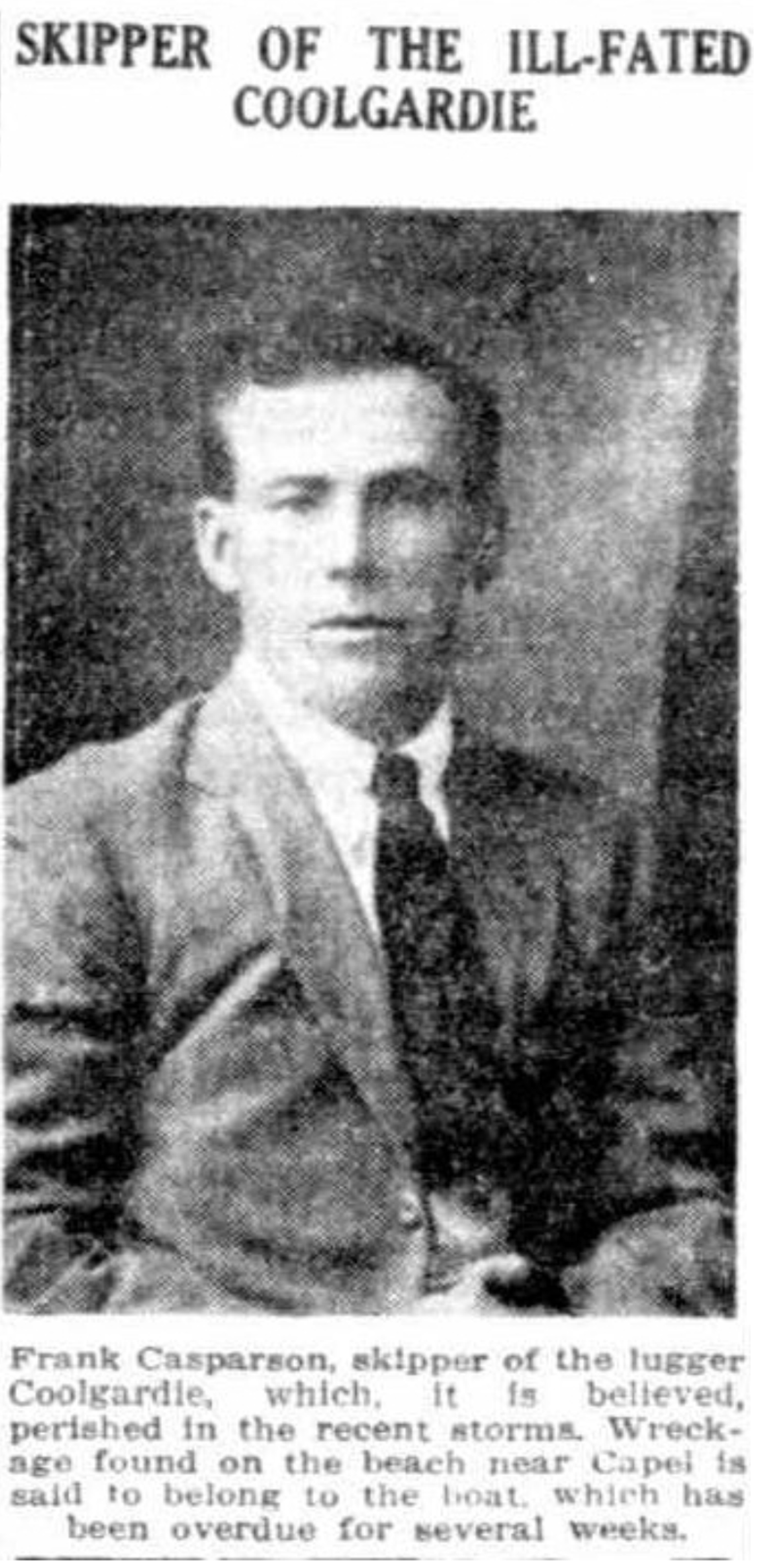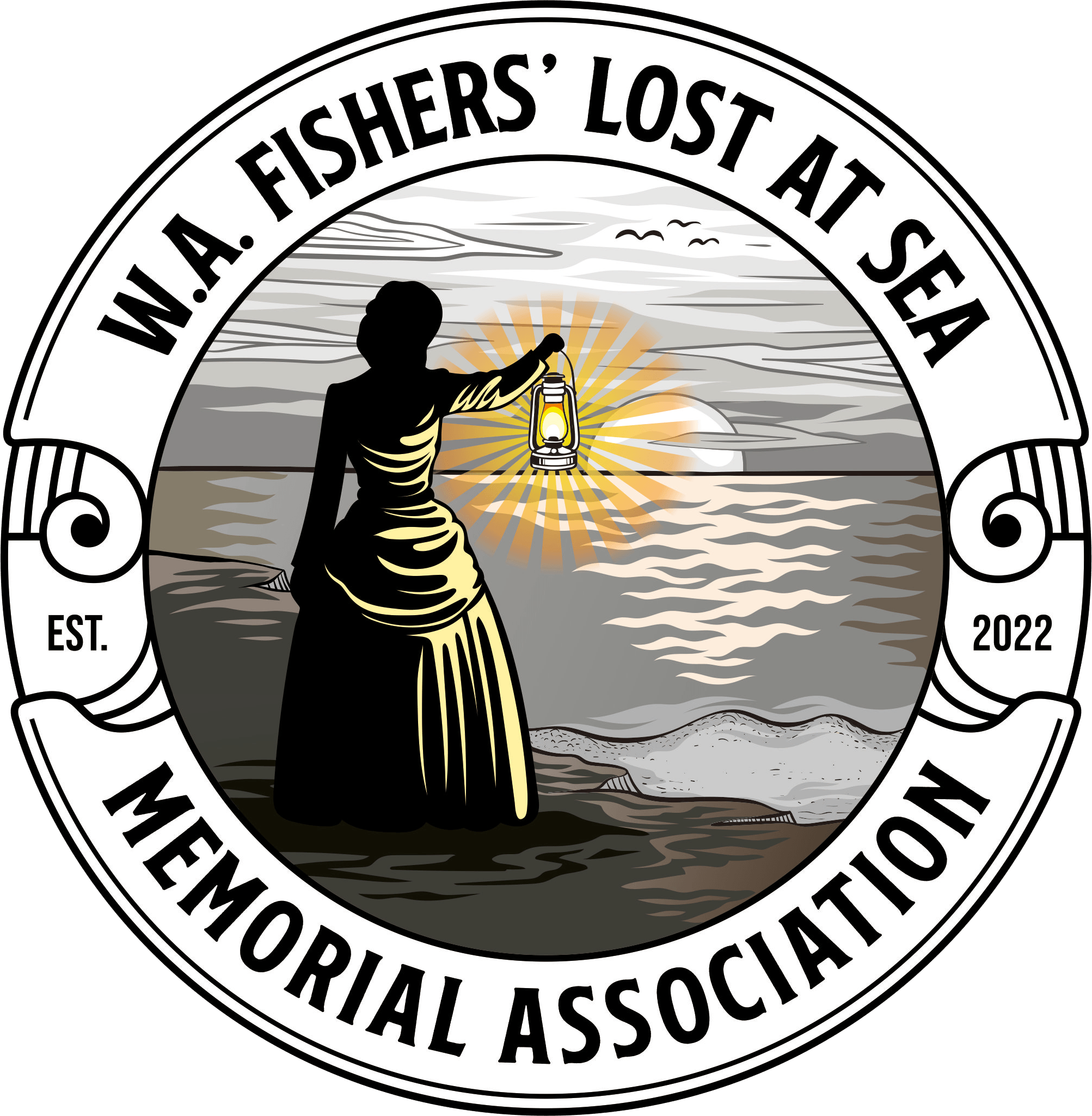Coolgardie
Vessel Name: Coolgardie
Frank Casparson
Martin Martinsen
Robert Sharpen
Lost at Sea; Never found
10 February 1937

News of the Coolgardie loss appeared in local newspapers
Coolgardie was a wooden lugger built in Fremantle in 1896 by William Chamberlain, a lugger builder, and the vessel’s owner, Mr Sweetman. She was 10.8 metres long, 3.5 metres wide with a draught of 0.98 metres. She weighed 11.2 tonnes and had a straight stem and counter stern.
Reportedly, Mr Sweetman’s son, F.J. Sweetman used Coolgardie for pearling from 1897.
Interestingly, Coolgardie remained unregistered until October 1902, when registration records indicate she was owned by William Alexander Chamberlain, who built her, and his son Alexander Chamberlain, a pearler, boat builder, fisherman and farmer. Alexander was residing in Broome, and Coolgardie was registered as a Broome vessel, B146.
There is little information about Coolgardie from then, until 1937, when she was owned by Mrs May Robinson, who lived in Claremont, Perth. At the age of 41 years, in 1937, Coolgardie was leased for two years to Frank Casparson (39), a Norwegian-born fisherman.
Frank had been fishing in Western Australia for fourteen years. He was married and living in Fremantle. The lease on Coolgardie had just expired, although Frank had a few more fishing trips planned.
Frank had two deckhands. One was another Norwegian fisherman, Martin Martinsen (65). Martin was unmarried and lived with the Casparsons’ in their Cantonment Street house in Fremantle. Martin had not been to sea with Frank before, although he was an experienced fisherman.
Frank and Martin had arrived in Western Australia as crew members of a whaling vessel in 1923.
Frank’s regular deckhand was Australian, Robert Sharpen (45), an ex-serviceman, who had enlisted in Kalgoorlie in 1916. He joined the 44th Battalion in January 1917 and was seriously wounded in March 1918, in the Battle of the Somme.
He was reported killed in action, although later records indicate he had a serious shoulder and lung gunshot wound that turned septic. He was hospitalised in England and shipped back to Australia in December 1918, where he was discharged in June 1920 after his treatment was completed.
By 1937 Robert was an experienced fisherman, married and living in Victoria Street, Fremantle.
On 25 January 1937, Frank loaded Coolgardie with three weeks of stores and ice, and put to sea with fishing boat Eva, heading for Cape Leeuwin.
He told his wife to expect him back in fourteen or fifteen days, on 10 or 11 February. Coolgardie and Eva were seen on 10 February 1937, fishing together approximately 20 miles south-west of Bunbury, by the crew on the Swansea.
Between 3pm and 4pm, Swansea’s skipper, Charles Axel, told Frank he could see a storm coming in from the north, and he was heading back to Bunbury for safe harbour.
He reported Coolgardie and Eva left the coast and headed south, beating into the wind towards Fremantle. They thought the sea would be calmer once they rounded Cape Leeuwin. That was the last sighting of Coolgardie.
A severe cyclone struck the area at approximately 6pm that evening, one of the worst to strike that part of the coast in eighty years.
Frank’s wife reported the Coolgardie missing four or five days after her expected return date. It was not unusual for fishing boats to return late, and Fremantle Police did not list the crew as missing until a few days later.
The Fishing Inspector was at Rottnest Island and they awaited his return to consult with him on the missing lugger. On 18 February 1937, newspapers reported on the missing vessel and seven police stations between Albany and Bunbury were involved in a search for the vessel. The tug Bonthorpe from Albany helped the search for Coolgardie.
On Saturday 11 February 1937, Eva limped into Albany. The crew spoke about three days of battling winds of 90 miles (145km) per hour and mountainous seas. They had not sighted Coolgardie.
On 24 February 1937, the roof of Coolgardie’s cabin with its compass attached was found 22 kilometres south of Bunbury and three kilometres north of the Capel River.
Police confirmed the cabin and compass were from Coolgardie when two former deckhands (Frederick Rodriguez and Martin Rolda), who knew the vessel, recognised the green outer and white inner paint of the jarrah cabin, and verified the measurements were correct.
The deckhands recognised the rectangular portholes and the mast hole in the cabin centre.
Despite a thorough search of the coast, no other wreckage was found. Police returned the compass to Mrs Robinson.
On 25 February 1937, The Daily News reported that all hope was abandoned for the crew of Coolgardie. Given the age of the vessel, her heavy ballast and the loss of her cabin, it was determined Coolgardie would have sunk quickly once the cabin broke away.
In May 1995, divers from the Western Australian Museum dived on a wreck that is sixteen kilometres south of Bouvard Reef, and wood samples proved to be the same as that of Coolgardie.
